Zhuoran Zheng
A PDE-Based Image Dehazing Method via Atmospheric Scattering Theory
Jun 10, 2025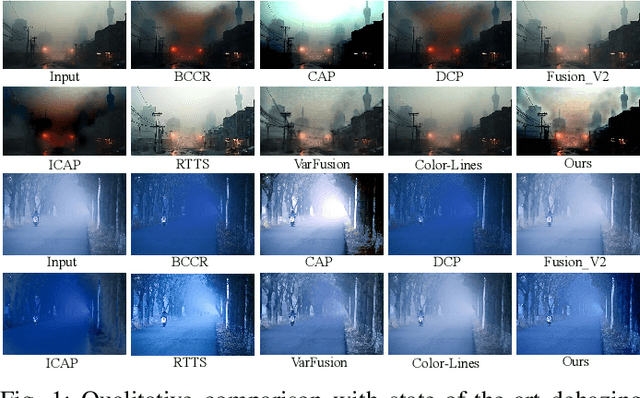
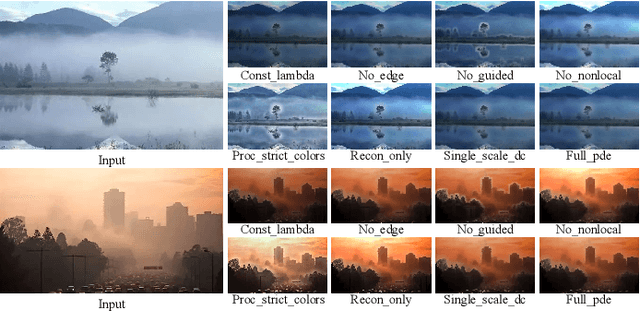
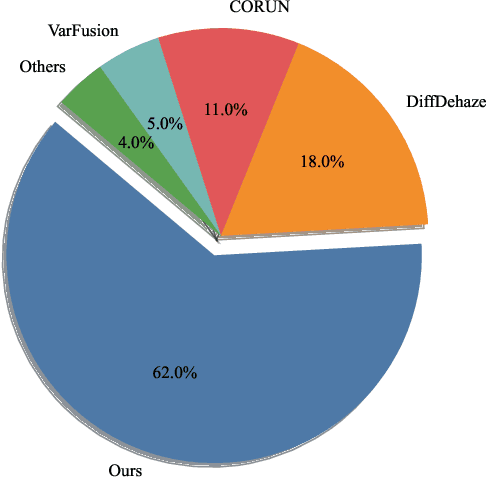
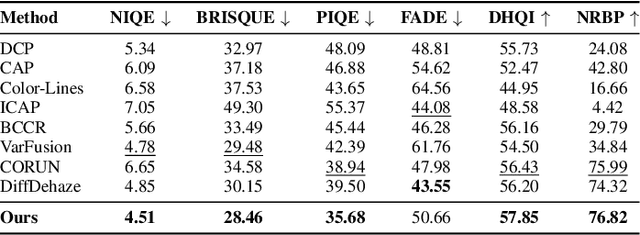
Abstract:This paper presents a novel partial differential equation (PDE) framework for single-image dehazing. By integrating the atmospheric scattering model with nonlocal regularization and dark channel prior, we propose the improved PDE: \[ -\text{div}\left(D(\nabla u)\nabla u\right) + \lambda(t) G(u) = \Phi(I,t,A) \] where $D(\nabla u) = (|\nabla u| + \epsilon)^{-1}$ is the edge-preserving diffusion coefficient, $G(u)$ is the Gaussian convolution operator, and $\lambda(t)$ is the adaptive regularization parameter based on transmission map $t$. We prove the existence and uniqueness of weak solutions in $H_0^1(\Omega)$ using Lax-Milgram theorem, and implement an efficient fixed-point iteration scheme accelerated by PyTorch GPU computation. The experimental results demonstrate that this method is a promising deghazing solution that can be generalized to the deep model paradigm.
M2Restore: Mixture-of-Experts-based Mamba-CNN Fusion Framework for All-in-One Image Restoration
Jun 09, 2025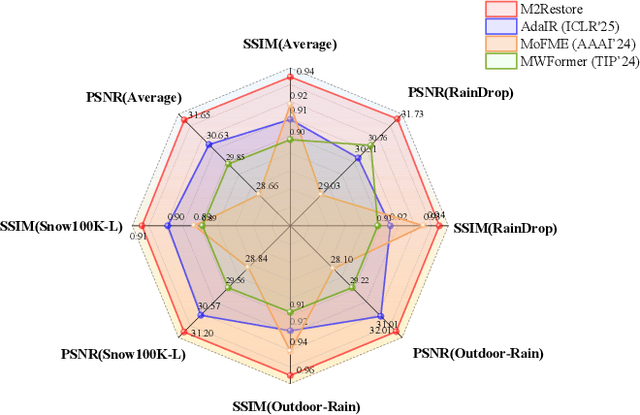
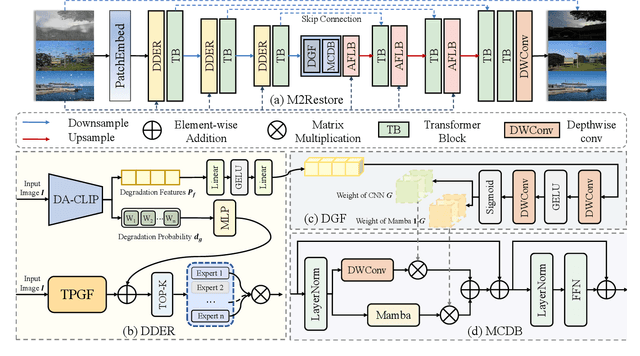
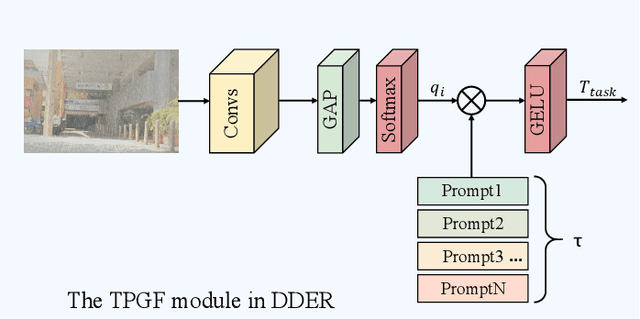
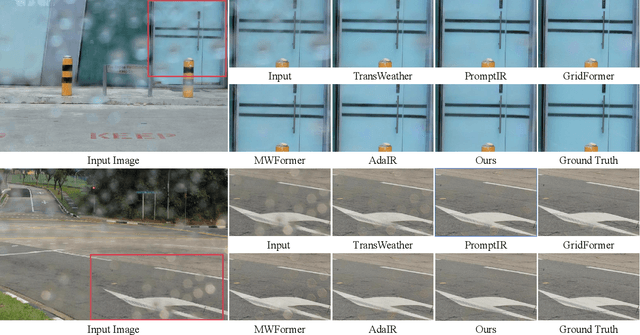
Abstract:Natural images are often degraded by complex, composite degradations such as rain, snow, and haze, which adversely impact downstream vision applications. While existing image restoration efforts have achieved notable success, they are still hindered by two critical challenges: limited generalization across dynamically varying degradation scenarios and a suboptimal balance between preserving local details and modeling global dependencies. To overcome these challenges, we propose M2Restore, a novel Mixture-of-Experts (MoE)-based Mamba-CNN fusion framework for efficient and robust all-in-one image restoration. M2Restore introduces three key contributions: First, to boost the model's generalization across diverse degradation conditions, we exploit a CLIP-guided MoE gating mechanism that fuses task-conditioned prompts with CLIP-derived semantic priors. This mechanism is further refined via cross-modal feature calibration, which enables precise expert selection for various degradation types. Second, to jointly capture global contextual dependencies and fine-grained local details, we design a dual-stream architecture that integrates the localized representational strength of CNNs with the long-range modeling efficiency of Mamba. This integration enables collaborative optimization of global semantic relationships and local structural fidelity, preserving global coherence while enhancing detail restoration. Third, we introduce an edge-aware dynamic gating mechanism that adaptively balances global modeling and local enhancement by reallocating computational attention to degradation-sensitive regions. This targeted focus leads to more efficient and precise restoration. Extensive experiments across multiple image restoration benchmarks validate the superiority of M2Restore in both visual quality and quantitative performance.
Latent label distribution grid representation for modeling uncertainty
May 27, 2025Abstract:Although \textbf{L}abel \textbf{D}istribution \textbf{L}earning (LDL) has promising representation capabilities for characterizing the polysemy of an instance, the complexity and high cost of the label distribution annotation lead to inexact in the construction of the label space. The existence of a large number of inexact labels generates a label space with uncertainty, which misleads the LDL algorithm to yield incorrect decisions. To alleviate this problem, we model the uncertainty of label distributions by constructing a \textbf{L}atent \textbf{L}abel \textbf{D}istribution \textbf{G}rid (LLDG) to form a low-noise representation space. Specifically, we first construct a label correlation matrix based on the differences between labels, and then expand each value of the matrix into a vector that obeys a Gaussian distribution, thus building a LLDG to model the uncertainty of the label space. Finally, the LLDG is reconstructed by the LLDG-Mixer to generate an accurate label distribution. Note that we enforce a customized low-rank scheme on this grid, which assumes that the label relations may be noisy and it needs to perform noise-reduction with the help of a Tucker reconstruction technique. Furthermore, we attempt to evaluate the effectiveness of the LLDG by considering its generation as an upstream task to achieve the classification of the objects. Extensive experimental results show that our approach performs competitively on several benchmarks.
UHD Image Dehazing via anDehazeFormer with Atmospheric-aware KV Cache
May 20, 2025



Abstract:In this paper, we propose an efficient visual transformer framework for ultra-high-definition (UHD) image dehazing that addresses the key challenges of slow training speed and high memory consumption for existing methods. Our approach introduces two key innovations: 1) an \textbf{a}daptive \textbf{n}ormalization mechanism inspired by the nGPT architecture that enables ultra-fast and stable training with a network with a restricted range of parameter expressions; and 2) we devise an atmospheric scattering-aware KV caching mechanism that dynamically optimizes feature preservation based on the physical haze formation model. The proposed architecture improves the training convergence speed by \textbf{5 $\times$} while reducing memory overhead, enabling real-time processing of 50 high-resolution images per second on an RTX4090 GPU. Experimental results show that our approach maintains state-of-the-art dehazing quality while significantly improving computational efficiency for 4K/8K image restoration tasks. Furthermore, we provide a new dehazing image interpretable method with the help of an integrated gradient attribution map. Our code can be found here: https://anonymous.4open.science/r/anDehazeFormer-632E/README.md.
Distribution-aware Dataset Distillation for Efficient Image Restoration
Apr 21, 2025Abstract:With the exponential increase in image data, training an image restoration model is laborious. Dataset distillation is a potential solution to this problem, yet current distillation techniques are a blank canvas in the field of image restoration. To fill this gap, we propose the Distribution-aware Dataset Distillation method (TripleD), a new framework that extends the principles of dataset distillation to image restoration. Specifically, TripleD uses a pre-trained vision Transformer to extract features from images for complexity evaluation, and the subset (the number of samples is much smaller than the original training set) is selected based on complexity. The selected subset is then fed through a lightweight CNN that fine-tunes the image distribution to align with the distribution of the original dataset at the feature level. To efficiently condense knowledge, the training is divided into two stages. Early stages focus on simpler, low-complexity samples to build foundational knowledge, while later stages select more complex and uncertain samples as the model matures. Our method achieves promising performance on multiple image restoration tasks, including multi-task image restoration, all-in-one image restoration, and ultra-high-definition image restoration tasks. Note that we can train a state-of-the-art image restoration model on an ultra-high-definition (4K resolution) dataset using only one consumer-grade GPU in less than 8 hours (500 savings in computing resources and immeasurable training time).
AdaQual-Diff: Diffusion-Based Image Restoration via Adaptive Quality Prompting
Apr 17, 2025Abstract:Restoring images afflicted by complex real-world degradations remains challenging, as conventional methods often fail to adapt to the unique mixture and severity of artifacts present. This stems from a reliance on indirect cues which poorly capture the true perceptual quality deficit. To address this fundamental limitation, we introduce AdaQual-Diff, a diffusion-based framework that integrates perceptual quality assessment directly into the generative restoration process. Our approach establishes a mathematical relationship between regional quality scores from DeQAScore and optimal guidance complexity, implemented through an Adaptive Quality Prompting mechanism. This mechanism systematically modulates prompt structure according to measured degradation severity: regions with lower perceptual quality receive computationally intensive, structurally complex prompts with precise restoration directives, while higher quality regions receive minimal prompts focused on preservation rather than intervention. The technical core of our method lies in the dynamic allocation of computational resources proportional to degradation severity, creating a spatially-varying guidance field that directs the diffusion process with mathematical precision. By combining this quality-guided approach with content-specific conditioning, our framework achieves fine-grained control over regional restoration intensity without requiring additional parameters or inference iterations. Experimental results demonstrate that AdaQual-Diff achieves visually superior restorations across diverse synthetic and real-world datasets.
AgentPolyp: Accurate Polyp Segmentation via Image Enhancement Agent
Apr 15, 2025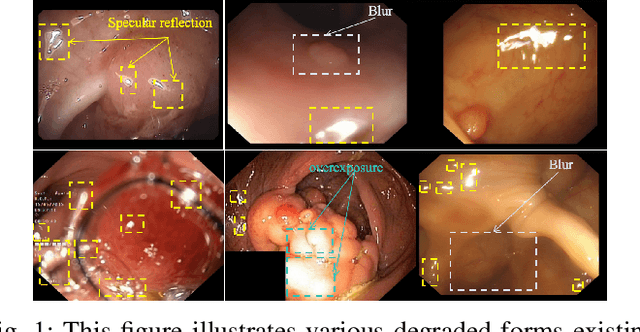
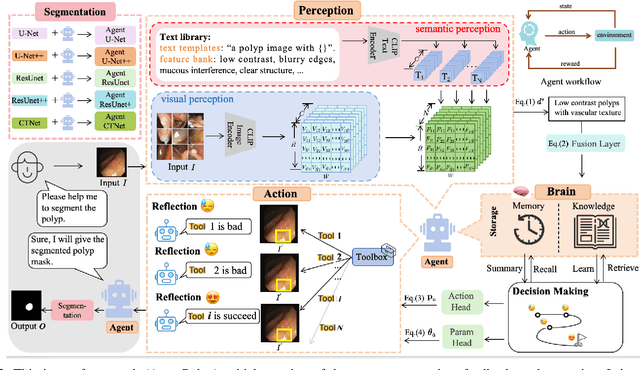
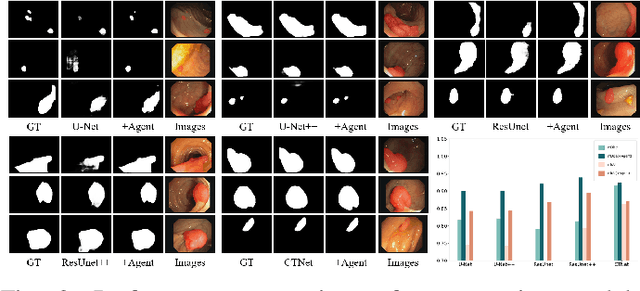

Abstract:Since human and environmental factors interfere, captured polyp images usually suffer from issues such as dim lighting, blur, and overexposure, which pose challenges for downstream polyp segmentation tasks. To address the challenges of noise-induced degradation in polyp images, we present AgentPolyp, a novel framework integrating CLIP-based semantic guidance and dynamic image enhancement with a lightweight neural network for segmentation. The agent first evaluates image quality using CLIP-driven semantic analysis (e.g., identifying ``low-contrast polyps with vascular textures") and adapts reinforcement learning strategies to dynamically apply multi-modal enhancement operations (e.g., denoising, contrast adjustment). A quality assessment feedback loop optimizes pixel-level enhancement and segmentation focus in a collaborative manner, ensuring robust preprocessing before neural network segmentation. This modular architecture supports plug-and-play extensions for various enhancement algorithms and segmentation networks, meeting deployment requirements for endoscopic devices.
UniFlowRestore: A General Video Restoration Framework via Flow Matching and Prompt Guidance
Apr 12, 2025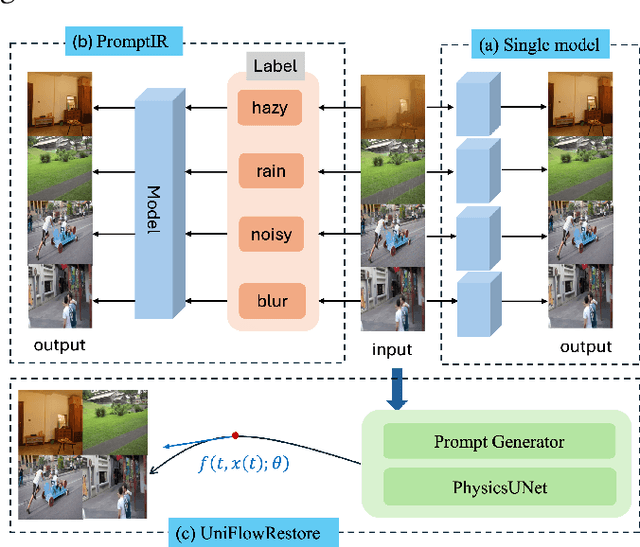
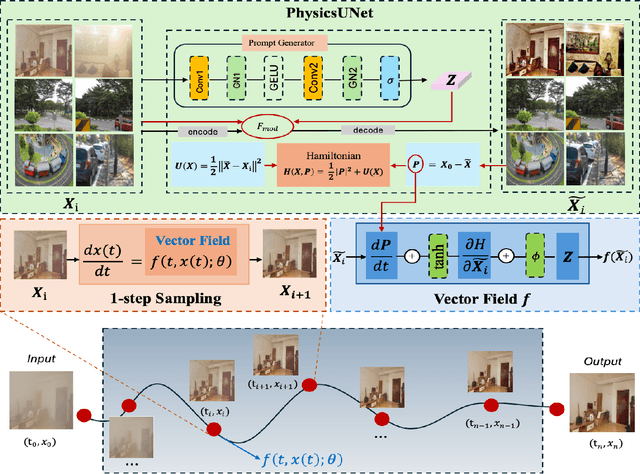

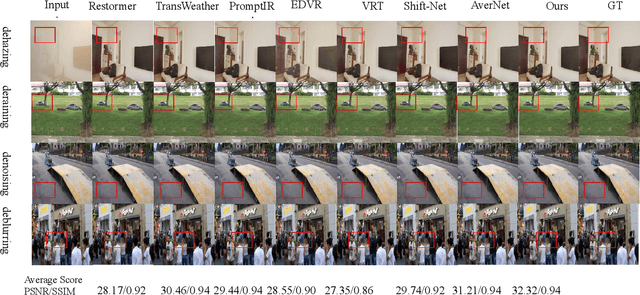
Abstract:Video imaging is often affected by complex degradations such as blur, noise, and compression artifacts. Traditional restoration methods follow a "single-task single-model" paradigm, resulting in poor generalization and high computational cost, limiting their applicability in real-world scenarios with diverse degradation types. We propose UniFlowRestore, a general video restoration framework that models restoration as a time-continuous evolution under a prompt-guided and physics-informed vector field. A physics-aware backbone PhysicsUNet encodes degradation priors as potential energy, while PromptGenerator produces task-relevant prompts as momentum. These components define a Hamiltonian system whose vector field integrates inertial dynamics, decaying physical gradients, and prompt-based guidance. The system is optimized via a fixed-step ODE solver to achieve efficient and unified restoration across tasks. Experiments show that UniFlowRestore delivers stateof-the-art performance with strong generalization and efficiency. Quantitative results demonstrate that UniFlowRestore achieves state-of-the-art performance, attaining the highest PSNR (33.89 dB) and SSIM (0.97) on the video denoising task, while maintaining top or second-best scores across all evaluated tasks.
Bridge the Gap between SNN and ANN for Image Restoration
Apr 02, 2025Abstract:Models of dense prediction based on traditional Artificial Neural Networks (ANNs) require a lot of energy, especially for image restoration tasks. Currently, neural networks based on the SNN (Spiking Neural Network) framework are beginning to make their mark in the field of image restoration, especially as they typically use less than 10\% of the energy of ANNs with the same architecture. However, training an SNN is much more expensive than training an ANN, due to the use of the heuristic gradient descent strategy. In other words, the process of SNN's potential membrane signal changing from sparse to dense is very slow, which affects the convergence of the whole model.To tackle this problem, we propose a novel distillation technique, called asymmetric framework (ANN-SNN) distillation, in which the teacher is an ANN and the student is an SNN. Specifically, we leverage the intermediate features (feature maps) learned by the ANN as hints to guide the training process of the SNN. This approach not only accelerates the convergence of the SNN but also improves its final performance, effectively bridging the gap between the efficiency of the SNN and the superior learning capabilities of ANN. Extensive experimental results show that our designed SNN-based image restoration model, which has only 1/300 the number of parameters of the teacher network and 1/50 the energy consumption of the teacher network, is as good as the teacher network in some denoising tasks.
UAKNN: Label Distribution Learning via Uncertainty-Aware KNN
Apr 02, 2025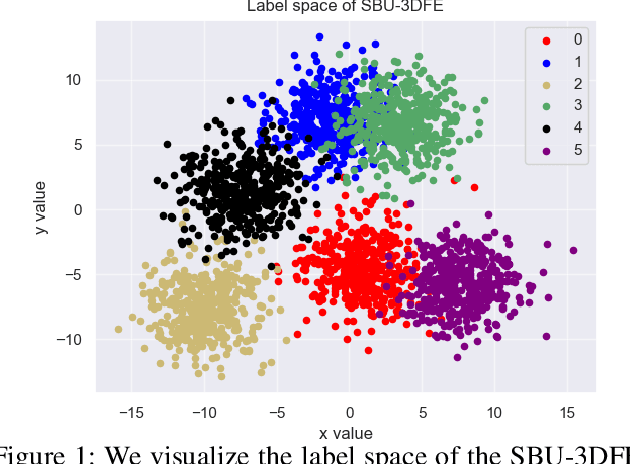
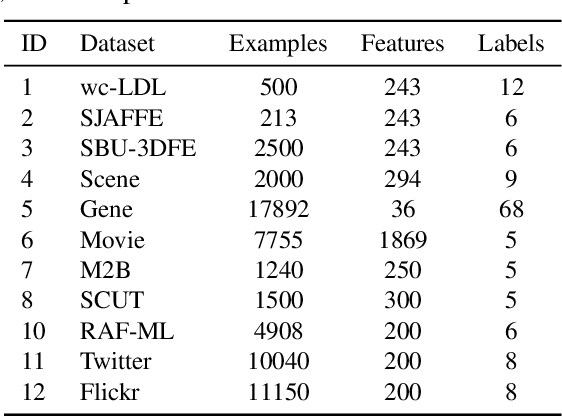
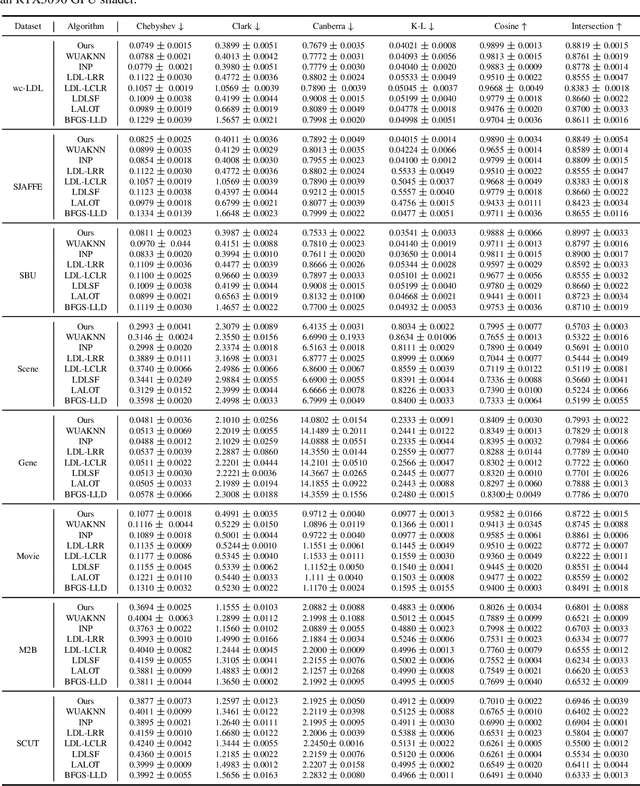
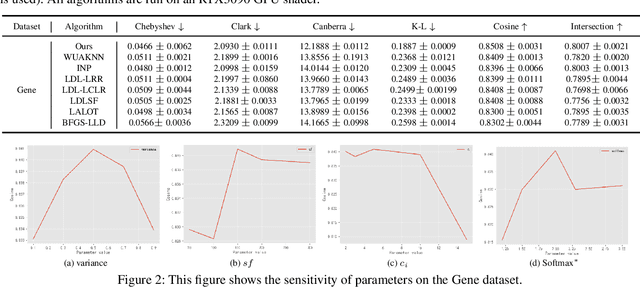
Abstract:Label Distribution Learning (LDL) aims to characterize the polysemy of an instance by building a set of descriptive degrees corresponding to the instance. In recent years, researchers seek to model to obtain an accurate label distribution by using low-rank, label relations, expert experiences, and label uncertainty estimation. In general, these methods are based on algorithms with parameter learning in a linear (including kernel functions) or deep learning framework. However, these methods are difficult to deploy and update online due to high training costs, limited scalability, and outlier sensitivity. To address this problem, we design a novel LDL method called UAKNN, which has the advantages of the KNN algorithm with the benefits of uncertainty modeling. In addition, we provide solutions to the dilemma of existing work on extremely label distribution spaces. Extensive experiments demonstrate that our method is significantly competitive on 12 benchmarks and that the inference speed of the model is well-suited for industrial-level applications.
 Add to Chrome
Add to Chrome Add to Firefox
Add to Firefox Add to Edge
Add to Edge